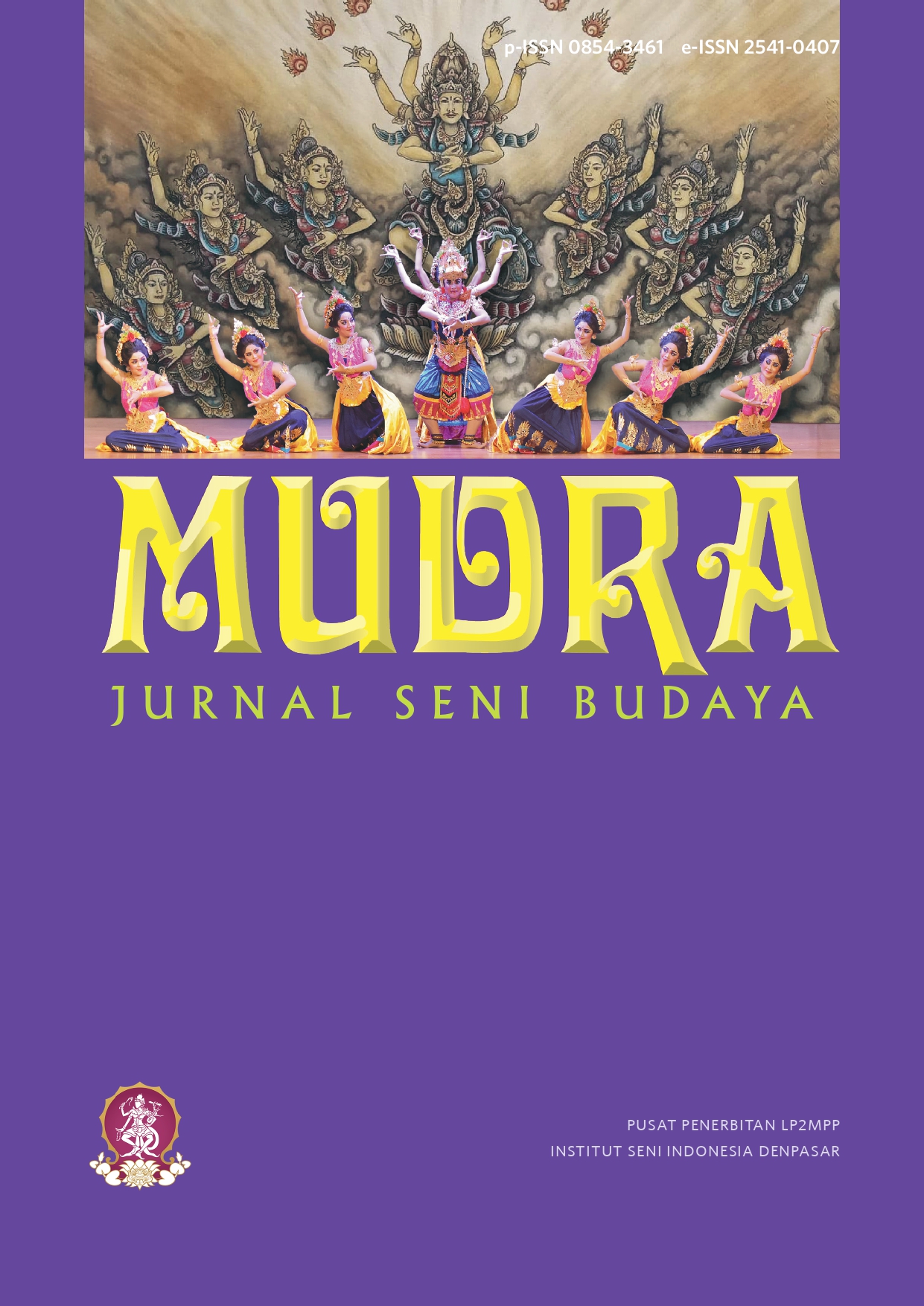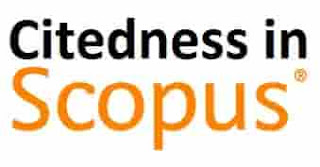The Heroism Value in Totokng Dance at The Nurutni’ Ceremony Dayak Salako Community in West Kalimantan
DOI:
https://doi.org/10.31091/mudra.v40i4.2950Keywords:
Dayak Salako, Heroism Value, Nurutni’ Ceremony, Totokng Dance, KayauAbstract
This study aims to explore and analyse the heroism values embodied in the Totokng dance, a traditional ritual performed as part of the Nurutni’ ceremony by the Dayak Salako community in West Kalimantan. These values play a crucial role in shaping collective character and preserving cultural identity amid the pressures of globalisation and the ongoing crisis in character Education. The research is driven by the limited academic attention given to the dimension of heroism within the cultural expressions of the Dayak people, particularly in the context of rice harvest rituals. Adopting a qualitative method with an ethnographic approach, the study collected data through participant observation, semi-structured interviews, documentation, and literature review. Informants were purposively selected based on their direct involvement in the tradition. The findings reveal that the Totokng dance conveys heroism values such as courage, sacrifice, solidarity, responsibility, and loyalty. These values are expressed through symbolic movements, the social roles of the dancers, and the spatial design of the performance, all of which are rooted in spiritual and historical relationships. Rather than functioning solely as an aesthetic performance, the dance serves as a medium for transmitting values and as a tool for character Education grounded in local wisdom. These findings reaffirm the importance of preserving intangible cultural heritage as a key component of sustainable development and multicultural Education in Indonesia.
Downloads
References
D. Setiawan, “Dampak Perkembangan Teknologi Informasi dan Komunikasi Terhadap Budaya,” Jurnal Simbolika: Research and Learning in Communication Study, vol. 4, no. 1, p. 62, Apr. 2018, doi: 10.31289/simbollika.v4i1.1474.
N. Balakleets, “Heroic Dimension of Post-Heroic Society,” Logos et Praxis, no. 2, pp. 39–48, Jul. 2023, doi: 10.15688/lp.jvolsu.2023.2.5.
I. V. Trotsuk and M. V. Subbotina, “Three questions to start the sociological study of heroism,” RUDN Journal of Sociology, vol. 21, no. 1, pp. 169–180, Dec. 2021, doi: 10.22363/2313-2272-2021-21-1-169-180.
A. Nurhaniffa and W. Haryana, “Penerapan Nilai-Nilai Kearifan Lokal Dalam Mempertahankan Budaya Kampung Adat Cireundeu di Era Modernisasi,” Cendekia: Jurnal Pendidikan dan Pembelajaran, vol. 16, no. 1, pp. 17–24, Sep. 2022, doi: 10.30957/cendekia.v16i1.714.
M. G. Bancin, C. Corry, and B. Haloho, “Pemahaman Nilai-Nilai Kepahlawanan Soekarno Dalam Pembentukan Karakter Peserta Didik Melalui Model Pembelajaran Role Playing,” Journal on Education, vol. 5, no. 4, pp. 13498–13514, Mar. 2023, doi: 10.31004/joe.v5i4.2357.
C. Geertz, The Interpretation of Cultures: Selected Essay. New York: Basic Books, 1973.
S. Takdir, Austronesia Dayaka: Tentang Kelompok Suku Salako Dayaka Borneo. Pontianak: Top Indonesia, 2017.
V. Turner, The Ritual Process: Structure and Anti Structure. Chicago: Aldine Publishing, 1971.
M. L. Hanifi, “Ritual Perang dalam Kebudayaan Suku Dayak,” Sabsa: Jurnal Kajian Budaya, vol. 11, no. 2, pp. 83–87, Dec. 2016.
J. U. Lontaan, Sejarah Hukum Adat dan Adat Istiadat Kalimantan Barat. Jakarta: Offset Bumirestu, 1975.
D. Riswanto, “Identifikasi Nilai-Nilai Pribadi Konseli Berdasarkan Kisah Kepahlawanan Pejuang Dayak,” Indonesian Journal of Counseling and Development, vol. 1, no. 2, pp. 123–132, Dec. 2019.
E. L. Guntar, Y. J. Moon, and A. L. Edu, "Nilai Heroisme pada Tarian Caci Masyarakat Manggarai Sebagai Refleksi Karakter Bangsa," Pustaka : Jurnal Ilmu-Ilmu Budaya, vol. 19, no. 2, p. 63, Aug. 2019, doi: 10.24843/PJIIB.2019.v19.i02.p01.
Wahyudiyanto, “‘Greget’ in The Surabaya Ngrema Dance Performance Representation of The Value of The Fighting Spirit of Arek Surabaya,” Mudra Jurnal Seni Budaya, vol. 38, no. 4, pp. 360–370, Jun. 2023, doi: 10.31091/mudra.v38i4.2210.
D. Oktariani, A. R. Oktaviari, and A. D. Natasia, “Fungsi Upacara Adat Ngensudah pada Masyarakat Dayak Melahui di Kabupaten Melawi,” ETNOREFLIKA: Jurnal Sosial dan Budaya, vol. 13, no. 2, pp. 219–232, Jun. 2024, doi: 10.33772/etnoreflika.v13i2.2507.
E. Sinibaldi and A. Parente, “UNESCO’s tangible and intangible cultural heritage: Sustainable development perspectives,” Pravovedenie, vol. 64, no. 1, pp. 47–56, 2020, doi: 10.21638/spbu25.2020.104.
H. Wijaya, Analisis data Kualitatif Teori Konsep dalam Penelitian Pendidikan. Makassar: Sekolah Tinggi Theologi Jaffray, 2020.
M. R. Fadli, “Memahami Desain Metode Penelitian Kualitatif,” Humanika, vol. 21, no. 1, pp. 2579–4248, 2021.
M. P. Sari, A. K. Wijaya, B. Hidayatullah, R. A. Sirodj, and M. W. Afgani, “Penggunaan Metode Etnografi dalam Penelitian Sosial,” Jurnal Pendidikan Sains dan Komputer, vol. 3, no. 01, pp. 84–90, Feb. 2023, doi: 10.47709/jpsk.v3i01.1956.
N. Dahlia, “Studi Tentang Proses Pengembangan Koleksi pada Perpustakaan STITMA Yogyakarta,” Ilmu Informasi Perpustakaan dan Kearsipan, vol. 9, no. 2, pp. 14, Jul. 2021, doi: 10.24036/113163-0934.
J. Sumardjo, “Dasar Humanisme Lokal Indonesia,” Jurnal Budaya Indonesia, vol. 1, no. 2, pp. 92–101, 2014.
N. D. Budi Setyaningrum, “Budaya Lokal di Era Global,” Ekspresi Seni, vol. 20, no. 2, pp. 102, Nov. 2018, doi: 10.26887/ekse.v20i2.392.
P. W. Kaka, “Makna simbolik dalam bahasa ritual Reba pada masyarakat Tiworiwu, Kecamatan Jerebuu, Kabupaten Ngada,” IMEDTECH (Instructional Media, Design and Technology), vol. 3, no. 1, pp. 38, Jun. 2019, doi: 10.38048/imedtech.v3i1.206.
D. N. Imanisa, W. Istiandini, and I. Fretisari, “Simbol dan Makna Gerak Tari Totokng dalam Upacara Adat Notokng di Kecamatan Sengah Temilak,” JPPK: Jurnal Pendidikan dan Pembelajaran Khatulistiwa, vol. 5, no. 5, pp. 1–13, 2016.
R. Derak, A. Amat, and N. A. Manap, “Kehormatan dan Maruah dalam Ngayau II Karya Amil Jaya,” Jurnal Komunikasi Borneo (JKoB), pp. 88–94, Aug. 2020, doi: 10.51200/jkob.vi.2518.
S. Seli and M. M. A. Hassan, “Makna Simbol-Simbol Fizikal Daripada Kearifan Tempatan dalam Cerita Ne’ Baruakng Kulup Sastera Lisan Dayak Kanayatn,” Jomas: Jurnal Pengajian Melayu, vol. 3, no. 2, pp. 70–105, 2016.
V. Turner, From Ritual to Theatre: The Human Seriousness of Play. New York: PAJ Publications, 1982.
R. Ka'ai-Mahuta, "The impact of colonisation on te reo Maori: A critical review of the State education system, "Te Kaharoa, vol. 4, no. 1, Dec. 2011, doi: 10.24135/tekaharoa.v4i1.117.
I. M. Bandem and F. E. Debor, "The impact of colonisation on te reo Maori: A critical review of the state education system,” Kuala Lumpur, Oxford University Press, 1995.
H. Darmadi, “Dayak Asal-Usul dan Penyebarannya di Bumi Borneo,” Sosial: Horizon: Jurnal Pendidikan Sosial, vol. 3, no. 2, pp. 322–340, 2016.
M. I. Lestari and T. Nugraheni, “Patriotic Values in Bandrong Ing Cilegon Dance,” in Proceedings of the 2nd International Conference on Arts and Design Education (ICADE 2019), Paris, France: Atlantis Press, 2020. doi: 10.2991/assehr.k.200321.056.
S. Parvathy and A. Balasubramanian, “Gender Identities and its Correlation with the Cultural Settings in the MulluKuruma Tribe of Wayanad, Kerala,” Rupkatha Journal on Interdisciplinary Studies in Humanities, vol. 12, no. 1, Jan. 2020, doi: 10.21659/rupkatha.v12n1.05.
H. Hogan and J. L. Liddell, “I had a mother that i could always go to’: gender role development and the intergenerational socialization of Indigenous women,” J Gend Stud, vol. 32, no. 6, pp. 525–538, Aug. 2023, doi: 10.1080/09589236.2023.2213661.
P. Bourdieu, “Language and Symbolic Power, Cambridge,” Harvard University Press, 1991.
S. J. Tambiah, “A Performative Approach to Ritual,” in Radcliffe-Brown Lecture in Sosial Anthropology, Proceedings of the British Academy, 1979, pp. 113–169.
J. E. Brown, The Sacred Pipe: Black Elk’s Account of the Seven Rites of the Oglala Sioux. USA: Univesity of Oklahoma Press, 1953.
J. Campbell, The Hero with a Thousand Faces, vol. New World Library. 2008.
B. Farnell, Dynamic Embodiment for Social Theory: “I Move Therefore I Am. New York: Routledge, 2012.
J. Streeck, “The emancipation of gestures,” Interactional Linguistics, vol. 1, no. 1, pp. 90–122, Jun. 2021, doi: 10.1075/il.20013.str.
R. Samuel, “Makna Simbolik Tari Manganda’ pada Ritual Mangrara Banua di Kecamatan Rinding Allo Kabupaten Toraja Utara,” Universitas Negeri Makassar, Makassar, 2022.
A. B. Duche-Pérez and L. J. Mamani-Daza, “Llamas, Barter and Travel Rituals: An Ethnographic Study on the Esquela Tusuy Dance of the Uchumiri Peasant Community, Condesuyos, Peru,” Religions (Basel), vol. 15, no. 5, pp. 534, Apr. 2024, doi: 10.3390/rel15050534.
M. Finnegan, “Dance, play, laugh,” Hunter Gatherer Research, vol. 1, no. 1, pp. 85–105, Jun. 2015, doi: 10.3828/hgr.2015.5.
R. Rochayati, “Konsep Mandala Dalam Tari Srimpi Kadang Premati,” Jurnal Sitakara, vol. 1, no. 1, Nov. 2016, doi: 10.31851/sitakara.v1i1.711.
N. Sahnir, “The Meaning of The Circular Formation of Molulo Dance In The Context Of Local Cultural Values Of The Tolaki Tribe,” JURNAL PAKARENA, vol. 7, no. 2, pp. 129, Oct. 2022, doi: 10.26858/p.v7i2.35992.
T. Kurniawan, “Simbolisme dalam Pesta Dalok Suku Uud Danum: Perspektif Hermeneutika Paul Ricoeur,” Studia Philosophica et Theologica, vol. 18, no. 2, pp. 179–197, Dec. 2019, doi: 10.35312/spet.v18i2.30.
H. Pangestu and Kuswarsantyo, “Functions of Lang Nginang Ritual Dance in Mengayau Traditional Rite in Belitang,” in Proceedings of the 3rd International Conference on Arts and Arts Education (ICAAE 2019), Paris, France: Atlantis Press, 2020, pp. 49–53. doi: 10.2991/assehr.k.200703.011.
Fatmawati and J. A. Dewantara, "Social resilience of indigenous community on the border: Belief and confidence in anticipating the spread of COVID-19 through the Besamsam custom in the Dayak community," J Community Appl Soc Psychol, vol. 32, no. 6, pp. 1216-1233, Nov. 2022, doi: 10.1002/casp.2611.
E. Durkheim, The Elementary Forms of Religious Life, K. E. Fields, Trans. United Kingdom: Oxford University , 2008.
E. Klinenberg, Palaces for How Social Infrastructure Can Help Fight Inequality, Polarization, and the Decline of Civic Life. New York : Crown Publishing, 2018.
F. Liadi et al., “Cultural Representation of Babukung Dance Funeral Ceremony Ritual of The Dayak Tomun Tribe as a Media for Character Building through Local Wisdom,” Millati: Journal of Islamic Studies and Humanities, vol. 9, no. 1, Aug. 2024, doi: 10.18326/millati.v9i1.893.
F. Berkes, Sacred Ecology: Traditional Ecological Knowledge and Resource Management, 4th ed. New York: Routledge, 2018.
J. Butler, Undoing Gender. New York: Routledge, 2004.
Downloads
Published
How to Cite
Issue
Section
License
Copyright (c) 2025 Deni Slamet, Tati Narawati, Agus Budiman

This work is licensed under a Creative Commons Attribution-NonCommercial-ShareAlike 4.0 International License.
- Copyright on any open access article in a journal published by Mudra Jurnal Seni Budaya is retained by the author(s).
-
The Creative Commons Attribution License 4.0 formalizes these and other terms and conditions of publishing articles.










